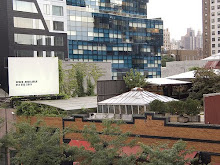

 1) view of the Highline Park, 2009. 2) Aerial view of the High Line from 18th Street going north (TheHighline.org archives). 3) "Death Avenue": 10th Avenue before they built the High Line (TheHighline.org archives)
1) view of the Highline Park, 2009. 2) Aerial view of the High Line from 18th Street going north (TheHighline.org archives). 3) "Death Avenue": 10th Avenue before they built the High Line (TheHighline.org archives)
Around 1900, Manhattan’s Meatpacking District was home to more than 250 slaughterhouses and meatpacking plants. The High Line was built in the 1930s in response to the huge number of accidents between freight trains and street-level traffic (there were so many accidents that 10th Avenue became known as Death Avenue). After years of public debate about the hazard, the City and State of New York and the New York Central Railroad agreed on Robert Moses’ West Side Improvement Project, which included the High Line. The High Line opened in 1934, lifting freight traffic 30 feet in the air, removing dangerous trains from the streets of Manhattan's largest industrial district. The growth of interstate trucking in the 1950’s led to a national drop in rail traffic, making trains run less frequently on the High Line until rail service stopped completely in 1980.
The Meatpacking District is so named because of its many meat-packing warehouses. In the 1970’s and 1980’s, transgendered sex workers began to use these warehouses after business hours to earn their livelihoods, and thus transform the meaning of the term “meat” into one with explicit sexual connotations. Time of day and geographic space converge to establish a public transgender identity. In recent decades, as industrial uses have declined in New York City, the Meatpacking District has seen a resurgence of other uses. Its historic cobblestone streets and low-lying industrial buildings are now home to many expensive restaurants, trendy nightclubs, posh photography studios, and fashion boutiques including such high-end designers as Stella McCartney, Matthew Williamson, Diane von Furstenberg and Alexander McQueen.
In 1999, Friends of the High Line (FOHL), a non-profit organization and private partner to the New York City Department of Parks & Recreation, was founded by Joshua David and Robert Hammond, residents of the High Line neighborhood, to advocate for the High Line's preservation and reuse as public open space. The first section of the re-designed High Line, running along 10th Avenue from Gansevoort Street to 20th Street, opened to the public in June 2009. The final section, 20th Street to 30th Street, is projected to open in 2010.
When all sections are complete, the High Line will be a mile-and-a-half-long elevated park, running through the West Side neighborhoods of the Meatpacking District, West Chelsea and Clinton/Hell's Kitchen. It features an integrated landscape, combining meandering concrete pathways with naturalistic plantings, evoking a sense of permanency with an abundance of slow-growing trees, flowers, and grass while preserving its original rail lines. Fixed and movable seating, lighting, and gourmet food stands are also included in the park. No bicycles, skateboards, skates, recreational scooters, or dogs are permitted and such activities as walking in the grass and flowers, playing loud music, performing, climbing, soliciting, feeding animals, or drinking alcohol are prohibited.
The history of the High Line parallels the histories of the neighborhoods it intersects. Although it once had an important industrial purpose and then became an abandoned structure for decades, it is now a tourist attraction and hailed by gentrifiers of the area, as well as architects and designers all over the globe, as an architectural feat. It’s pristine condition is closely monitored by guards and park employees and seemingly erases the blue collar industry and “seedy” sexual landscape of the gendered “other”—spaces that once thrived in this area, yet are now invisible.
Directions and hours: Stairwell access is located on Gansevoort Street, 14th Street, 16th Street, 18th Street and 20th Street. You can get to the High Line by subway (A/C/E/L to 14th Street/8th Avenue, C/E to 23rd Street, 1/2/3 to 14th Street, 1 to 18th Street, 1 to 23rd Street) or by bus (M11 to Washington Street, M14 to 9th Avenue, M23 to 10th Avenue, M34 to 10th Avenue). Park hours are 7am-10pm during the summer and 7am-8pm during the winter.
Sources
Namaste, Vivianne K. “Chapter 6: Genderbashing: Sexuality, Gender, and the Regulation
of Public Space”. Invisible Lives: The Erasure of Transsexual and Transgendered
People. Chicago: University of Chicago Press, 2000.
Schmelzkopf, Karen. “Urban Community Gardens as Contested Space”. Geographical
Review, Vol. 85, No. 3 (Jul., 1995), pp. 364-381. American Geographical
Society, 1995.
Vigdor, Acob L. "Does Gentrification Harm the Poor?". Brookings-Wharton Papers on
Urban Affairs, pp. 133-182. The Brookings Institution, 2002.

High Line post seemed an old place with interesting history that will definitely inspire new travelers. Great! short term park and fly deals
ReplyDelete